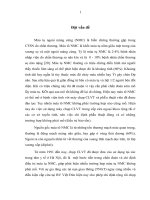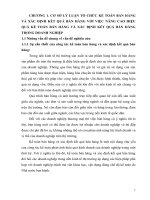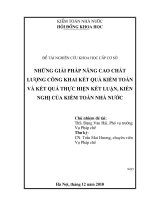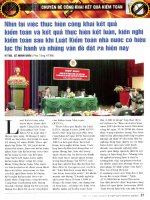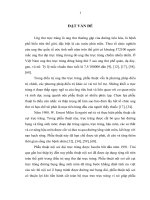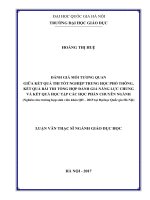2. Luan An (Eng).Pdf
Bạn đang xem bản rút gọn của tài liệu. Xem và tải ngay bản đầy đủ của tài liệu tại đây (1.46 MB, 125 trang )
MINISTRY
MINISTRY
OF EDUCATION AND TRAINING
OF DEFENCE
108 INSTITUTE OF CLINICAL MEDICAL AND
PHARMACEUTICAL SCIENCES
BY VIEN HOANG LONG MD
CLINICAL, PARACLINICAL CHARACTERISTICS,
ELECTROPHYSIOLOGICAL FEATURES AND RESULT OF
PERSISTENT ATRIAL FIBRILLATION ABLATION WITH
RADIOFREQUENCY ENERGY
A Dissertation for the Degree of
Medical Doctor of Cardiology
HA NOI - 2023
MINISTRY
MINISTRY
OF EDUCATION AND TRAINING
OF DEFENCE
108 INSTITUTE OF CLINICAL MEDICAL AND
PHARMACEUTICAL SCIENCES
BY VIEN HOANG LONG MD
CLINICAL, PARACLINICAL CHARACTERISTICS,
ELECTROPHYSIOLOGICAL FEATURES AND RESULT OF
PERSISTENT ATRIAL FIBRILLATION ABLATION WITH
RADIOFREQUENCY ENERGY
A Dissertation for the Degree of
Medical Doctor of Cardiology
Speciality: Internal Medicine/Internal Cardiology
Code: 9720107
HA NOI - 2023
ACKNOWLEDGMENTS
For the completion of this dissertation, my deepest appreciations go to:
- 108 Institute of clinical medical and pharmaceutical sciences
- Department of Post graduates of 108 Central Military Hospital
- Department of Internal Cardiological Medicine
- Board of Director of Vietnam National Heart Institute - Bach Mai
Hospital
- C7 Department, Cardiac catheterization laboratory Department, Outpatients service Department, Electrography and Electrophysiology Department
of Vietnam National Heart Institute - Bach Mai Hospital
Special thanks to:
- My dearest teachers: Associate Professor Pham Quoc Khanh and
Associate Professor Pham Nguyen Son
- Pham Tran Linh, PhD
- Phan Dinh Phong, PhD
- Dr. Le Vo Kien, Dr. Tran Tuan Viet, Dr. Nguyen Thi Le Thuy, Dr.
Nguyen Duy Linh, Dr. Nguyen Duy Tuan
I am personally indebted to:
- My past grandparents Vien Van Doan, Nguyen Thi Bi, my beloved
parents Vien Van Doan, Nguyen Thi Kim Hoang for giving my birth, my wife
Le Thanh Ha, my kids Hoang Bach and Nhat Quang for their love to me
- My patients, my staff without them this work would never be completed
PROTESTATION
I hereby declare that this is my own research, under the guidance of Assoc.
Prof. Pham Quoc Khanh and Assoc. Prof. Pham Nguyen Son. All data in this
dissertation were collected by myself, and the results presented are honest and
have not been published in any other research work in Vietnam. I ensure the
honesty of the data and the results obtained from data processing in this study.
Hanoi, 26th June 2023
Author of the dissertation
Vien Hoang Long
LIST OF ABBREVIATIONS
2D
2-dimensional
ACC
American College of Cardiology
AFL
Atrial flutter
AH
Atrial - his
AHRE
Atrial high-rate episode
APHRS
Asia Pacific Heart Rhythm Society
AT
Atrial tachycardia
AVN
Atrioventricular node
BMI
Body mass index
BP
Blood pressure
bpm
beats per minute
CHA2DS2-VASc
Stroke risk score CHA2DS2-VASc
DBP
Diastolic blood pressure
ECAS
European Cardiac Arrhythmia Society
ECG
Electrocardiogram
EHRA
European Heart Rhythm Association
ERP
Effective refractory period
ESC
European Society of Cardiology
FU
Follow-up
GMR
Grade of mitral valve regurgitation
GTR
Grade of tricuspid valve regurgitation
HASBLED
Bleeding risk score HASBLED
HCM
Hypertrophic cardiomyopathy
HRS
Heart Rhythm Society
HV
His - ventricular interval
LA
Left atrial
LIPV
Left inferior pulmonary vein
LSPV
Left superior pulmonary vein
LVZ
Low voltage zone
PA
P - atrial interval
PAC
Premature atrial complex
PV
Pulmonary vein
PVC
Premature ventricular complex
PVI
Pulmonary vein isolation
RIPV
Right inferior pulmonary vein
RSPV
Right superior pulmonary vein
SBP
Systolic blood pressure
SNRT
Sinus node recovery time
SNRTc
Corrected sinus node recovery time
SOLAECE
Sociedad Latinoamericana de Estimulación
Cardíaca y Electrofisiología
TABLE OF CONTENTS
INTRODUCTION .................................................................................................... 1
CHAPTER 1. LITERATURE OVERVIEW ....................................................... 3
1.1. Diagnosis of atrial fibrillation................................................................ 3
1.1.1. Definition of atrial fibrillation ........................................................ 3
1.1.2. Diagnostic criteria for atrial fibrillation.......................................... 3
1.1.3. Classification of AF ........................................................................ 4
1.2. Atrial fibrillation management .............................................................. 5
1.2.1. ACB pathway: ................................................................................ 5
1.2.2. Indications for atrial fibrillation catheter ablation .......................... 5
1.3. Recent studies about atrial fibrillation catheter ablation ....................... 6
1.3.1. Overview of study about atrial fibrillation in Vietnam .................. 6
1.3.2. Overview of studies about persistent atrial fibrillation ablation ..... 8
CHAPTER 2. SUBJECTS AND METHODS .................................................... 12
2.1. Subjects ................................................................................................ 12
2.1.1. Inclusion criteria ........................................................................... 12
2.1.2. Exclusion criteria .......................................................................... 13
2.1.3. Diagnostic criteria used in the study............................................. 13
2.2. Methods ............................................................................................... 15
2.2.1. Design and sample size................................................................. 15
2.2.2. Data collection .............................................................................. 15
2.3. Study data analysis .............................................................................. 28
2.4. Study ethics.......................................................................................... 28
CHAPTER 3. RESULTS ....................................................................................... 30
3.1. General characteristics of the study group .......................................... 30
3.1.1. Baseline characteristics................................................................. 30
3.1.2. Age and sex distribution ............................................................... 30
3.2. Clinical, paraclinical characteristics and electrophysiological features
............................................................................................................ 32
3.2.1. Clinical characteristics .................................................................. 32
3.2.2. Paraclinical characteristics ........................................................... 34
3.2.3. Electrophysiological features of persistent atrial fibrillation patients
...................................................................................................... 37
3.3. Results of catheter ablation for persistent atrial fibrillation ................ 42
3.3.1. Technique index in catheter ablation for persistent atrial fibrillation
...................................................................................................... 42
3.3.2. Result within 24 hours after catheter ablation .............................. 44
3.3.3. Results at 1 month follow-up........................................................ 45
3.3.4. Results after 3 months follow-up.................................................. 47
3.3.5. Results after 6-month follow-up ................................................... 50
3.3.6. The proportion of maintaining sinus rhythm and clinical and
paraclinical changes after intervention ......................................... 51
3.3.7. Evaluation of some factors related to the success rate of maintaining
sinus rhythm after persistent atrial fibrillation ablation .................... 55
3.3.8. Complications of persistent atrial fibrillation catheter ablation ... 60
CHAPTER 4. DISCUSSIONS .............................................................................. 61
4.1. General characteristics of patients in the study ................................... 61
4.2. Clinical and paraclinical characteristics of patients in the study ......... 62
4.2.1. Clinical characteristics .................................................................. 62
4.2.2. Paraclinical characteristics ........................................................... 63
4.2.3. Electrophysiological features of patients in study ........................ 65
4.3. Results of persistent atrial fibrillation catheter ablation ...................... 69
4.3.1. Strategy and technique of persistent atrial fibrillation catheter
ablation ......................................................................................... 69
4.3.2. AF-free rate after catheter ablation for persistent AF
.............. 76
4.3.3. Some factors affecting the success rate after catheter ablation for
persistent AF ................................................................................. 81
4.3.4. Safety of persistent atrial fibrillation catheter ablation ................ 83
4.4. Limitations ........................................................................................... 84
CONCLUSIONS ..................................................................................................... 85
RECOMMENDATIONS ...................................................................................... 87
LIST OF PUBLISHED PAPERS OF THE DISSERTATION
REFERENCES
SAMPLES OF MEDICAL RECORD FOR THE STUDY
LIST OF TABLES
Table 1.1: Definition of AF according to ESC AF guideline 2020 ................. 3
Table 1.2: Classification of AF ........................................................................ 4
Table 1.3: HRS/EHRA/ECAS/APHRS/SOLAECE indications for catheter
ablation .......................................................................................... 5
Table 2.1: European Heart Rhythm Association (EHRA) symptom scale ..... 12
Table 3.1. Baseline characteristics.................................................................. 30
Table 3.2. Sex and age subgroups distribution ............................................... 31
Table 3.3. Risk factors and cardiovascular diseases history ........................... 32
Table 3.4. Physical examination data ............................................................. 34
Table 3.5. Blood test index of patients ........................................................... 34
Table 3.6. Transthoracic cardiac echo index of patients ................................ 35
Table 3.7. Left atrial volume and pulmonary veins' diameter on MSCT ....... 36
Table 3.8. The proportion of electrical connection between the pulmonary veins
and the left atrium......................................................................... 37
Table 3.9. Acute success rate of PVI .............................................................. 37
Table 3.10. Some other atrial arrhythmias and substrates besides AF ........... 38
Table 3.11. Basic intervals after sinus rhythm recovered ............................... 39
Table 3.12. Sinus node recovery time ............................................................ 40
Table 3.13. SNRT by age and sex .................................................................. 40
Table 3.14. ERP of atrial, ventricular, atrial - ventricular node ..................... 41
Table 3.15. Ablation time, number of lesions, procedure's time and number of
cardioversions ............................................................................... 43
Table 3.16. 24-hour Holter ECG within 24 hours after catheter ablation ...... 44
Table 3.17. Transthoracic cardiac echo after catheter ablation ...................... 44
Table 3.18. Proportion of sinus rhythm maintain within 24 hour of catheter
ablation on Holter ECG ................................................................ 45
Table 3.19. 24-hour ECG at 1-month follow-up ............................................ 46
Table 3.20. 24-hour Holter ECG at 3-month follow-up ................................. 49
Table 3.21. 24-hour Holter ECG at 6-month follow-up ................................. 50
Table 3.22. Compare blood test before catheter ablation and 3 times visit .... 53
Table 3.23. Cardiac echo index baseline and 3 times follow-up .................... 54
Table 3.24. Risk ratio of AF recurrence after 6-month FU in patient who had
AF within 24 hours after CA ........................................................ 55
Table 3.25. Risk ratio of AF recurrence after 6-month FU in patient who had
AF at 1-month FU ........................................................................ 56
Table 3.26. Risk ratio of AF recurrence after 6-month FU in patient who had
AF at 3-month FU ........................................................................ 56
Table 3.27. Time from AF diagnosis to CA hazard radio of AF recurrence .. 58
Table 4.1: Basic intervals ............................................................................... 67
Table 4.2: ERP of atrial, AV node and ventricular......................................... 67
Table 4.3. Sinus node recovery time ............................................................. 68
Table 4.4: Procedure time and fluoroscopy time of AF ablation .................. 73
Table 4.5: The rate of successful conversion during the intervention and the
follow-up results ........................................................................... 75
Table 4.6: Early AF recurrence rate in first 3 months .................................... 78
Table 4.7: Rate of AF free after 6-month FU after first catheter ablation ...... 79
LIST OF FIGURES
Figure 3.1. Sex distribution....................................................................................... 31
Figure 3.2. Age distribution ..................................................................................... 31
Figure 3.3. Clinical symptoms ................................................................................. 33
Figure 3.4. EHRA scale symptoms before ablation ................................................ 34
Figure 3.5. Ablation strategies in catheter ablation for persistent atrial fibrillation.... 42
Figure 3.6. 1-month follow-up clinical symptom based on EHRA score.............. 46
Figure 3.7. 3-month follow-up clinical symptom based on EHRA score.............. 48
Figure 3.8. 6-month follow-up clinical symptom based on EHRA score.............. 50
Figure 3.9: Rate of maintaining sinus rhythm after catheter ablation for persistent
atrial fibrillation ..................................................................................... 51
Figure 3.10. Clinical symptoms based on EHRA score of patients before ablation
and each visit follow-up times .............................................................. 52
Figure 3.11. Comparing clinical symptoms between AF recurrence and AF freedom
................................................................................................................ 52
Figure 3.12: Freedom of AF between 2 groups of .................................................. 57
Figure 3.13: Freedom of AF between 2 groups of LA diameter ............................ 59
Figure 3.14: Freedom AF between 2 age groups .................................................... 59
Figure 3.15: Freedom of AF between 2 BMI groups.............................................. 60
Figure 4.1: Combined point estimates and 95% CI for single-procedure and
multiple-procedure cohorts across all six ablation approaches........... 80
LIST OF PICTURES
Picture 1.1: AF on 12 lead ECG................................................................................. 4
Picture 1.2: ESC guideline for catheter ablation of AF 2020. .................................. 6
Picture 2.1. Evaluation of sinus node recovery time. .............................................. 15
Picture 2.2. Angiography system ............................................................................. 17
Picture 2.3. Cardiac Stimulator (a), Electrophysiology System (b) and RF Ablation
Generator (c) ................................................................................... 17
Picture 2.4. 3D Ensite system and the locations of electrode patches.................... 18
Picture 2.5. The steerable, decapolar circular mapping catheter ............................ 18
Picture 2.6. The irrigated tip ablation catheter......................................................... 19
Picture 2.7. (a) The left subclavian venous access for placement of coronary sinus
electrode catheter, (b) The right femoral venous accesses for two
long sheaths and the left femoral venous access for placement of
right ventricular electrode catheter ................................................ 20
Picture 2.8: Sheath 6F, long sheath SLO, septal puncture needle .......................... 21
Picture 2.9. The right ventricle is stimulated and the left atrial imaging is performed
in LAO 30º view (a) and RAO 30º view (b) 3D reconstruction of
the left atrium and voltage mapping .............................................. 21
Picture 2.10. Elimination of all the potentials in the PVs. (a) Pulmonary venous
electrical signals before ablation; (b) Pulmonary venous electrical
signals after ablation (Patient Huynh Cong L.)............................. 23
Picture 2.11. The atrium is captured when pacing from the coronary sinus electrode,
but no conduction into the PV (no electrical signal is recorded from
the PV electrode placed inside the left superior pulmonary vein).
......................................................................................................... 23
Picture 2.12. No conduction into the left atrium when pacing from the PV1-2
electrode. ......................................................................................... 24
Picture 2.13. (a) Endocardial mapping of the left atrium is performed before ablation
based on MSCT (b) Reconstruction of the left atrium and
identification of low voltage areas after undergoing pulmonary vein
isolation ablation ............................................................................. 25
Picture 2.14. Basic interval measurements in sinus rhythm ................................... 25
Picture 2.15. Patient flow and study protocol .......................................................... 28
1
INTRODUCTION
Over the past 20 years, atrial fibrillation (AF) has become one of the most
investigated arrhythmias and has incurred significant healthcare costs in
developed countries. Besides causing symptoms and affecting quality of life,
AF is a leading cause of systemic thromboembolism, stroke, heart failure,
mortality, and increased hospital readmission rate in patients with
cardiovascular disease. According to the European Society of Cardiology
statistics in 2016, there are approximately 43.6 million AF patients worldwide,
and the incidence of AF increases with age and coexisting cardiovascular risk
factors [1].
Unlike other arrhythmias, AF tends to progress from paroxysmal AF to
persistent and eventually long-standing persistent AF over time. Massimo
Zoni-Berisso et al.'s population-based study in Europe in 2014 reported that
50% of AF patients had long-standing persistent AF, 20-30% had paroxysmal
AF, and persistent AF [2]. Early rhythm control intervention for paroxysmal
and persistent AF would reduce the progression to long-standing persistent AF.
Until now, there have been many advances in the management of AF with
promising results. In 1994, Haissenguerre M. first applied radiofrequency
energy to treat AF patients, but the success rate was low (33-60%), the
complication rate was high, and the procedure took up to 5-6 hours. From 1996,
Pappone C. used the three-dimensional CARTO cardiac mapping system to
treat AF with radiofrequency energy. Since then, several systems such as
ENSITE VELOCITY, the new-generation CARTO system have made
radiofrequency ablation of AF widespread and become the most advanced
approach in AF treatment with a high success rate and a low complication rate.
Despite many advances and improvements in tools, techniques, and
success rates in maintaining sinus rhythm after intervention for patients with
2
persistent AF, the success rate is not as high as those with paroxysmal AF. In
addition, the cost of an ablation procedure for AF (especially in Vietnam) is
also high. Therefore, ablation intervention for persistent AF has not been
widely performed and standardised in Vietnam. Do patients with persistent AF
have different clinical, paraclinical, and electrophysiological characteristics to
those with paroxysmal AF? What are the difficulties and practical effectiveness
of performing ablation intervention on these patients?
Research objective:
For the reasons above and with the desire to apply a new method in
Vietnam as well as to make this modern treatment method more widespread,
we
conducted
the
study
"Clinical,
paraclinical
characteristics,
electrophysiological features, and result of persistent atrial fibrillation
ablation with radiofrequency energy". Research aimed to achieve the
following two objectives:
1. To
assess
clinical,
paraclinical
characteristics
and
electrophysiological features of persistent atrial fibrillation patients.
2. To evaluate results within 6-month follow-up after persistent atrial
fibrillation ablation.
3
CHAPTER 1
LITERATURE OVERVIEW
1.1. Diagnosis of atrial fibrillation
1.1.1. Definition of atrial fibrillation
Table 1.1: Definition of AF according to ESC AF guideline 2020 [3]
Definition
A supraventricular tachyarrhythmia with uncoordinated atrial
electrical activation and consequently ineffective atrial
contraction.
Electrocardiographic characteristics of AF include:
AF
• Irregularly irregular R-R intervals (when atrioventricular
conduction is not impaired), • Absence of distinct repeating P
waves, and
• Irregular atrial activations.
Symptomatic or asymptomatic AF that is documented by
Clinical
AF
surface ECG.
The minimum duration of an ECG tracing of AF required to
establish the diagnosis of clinical AF is at least 30 seconds, or
entire 12-lead ECG
1.1.2. Diagnostic criteria for atrial fibrillation
The diagnosis of AF is based on an ECG tracing heart rhythm with no
discernible repeating P waves and irregular R-R intervals. ECG tracing of ≥ 30
seconds is diagnostic of clinical AF [4] (Class IB).
4
Picture 1.1: AF on 12 lead ECG
1.1.3. Classification of AF
Table 1.2: Classification of AF [3]
AF pattern
Definition
First diagnosed
AF not diagnosed before, irrespective of its duration or
the presence/severity of AF-related symptoms.
Paroxysmal
AF that terminates spontaneously or with intervention
within 7 days of onset.
Persistent
AF that is continuously sustained beyond 7 days,
including episodes terminated by cardioversion (drugs or
electrical cardioversion) after >_7 days
Long-standing
persistent
Continuous AF of >12 months’ duration when decided
to adopt a rhythm control strategy.
Permanent
AF that is accepted by the patient and physician, and no
further attempts to restore/maintain sinus rhythm will be
undertaken. Permanent AF represents a therapeutic
attitude of the patient and physician rather than an
inherent pathophysiological attribute of AF, and the term
should not be used in the context of a rhythm control
strategy with antiarrhythmic drug
therapy or AF ablation. Should a rhythm control strategy
be adopted, the arrhythmia would be reclassified as
‘long-standing persistent AF’.
5
1.2. Atrial fibrillation management
1.2.1. ACB pathway:
According to ESC AF guideline 2020, the simple Atrial fibrillation Better
Care (ABC) was recommended for AF management.
A: Anticoagulation/Avoid Stroke
B: Better symptom control (choose rhythm control or rate control
strategy)
C: Cardiovascular risk factors and concomitant diseases control
1.2.2. Indications for atrial fibrillation catheter ablation
Table 1.3: HRS/EHRA/ECAS/APHRS/SOLAECE indications for catheter
ablation [5]
Class
Level of
evidence
Symptomatic AF
Paroxysmal: Catheter ablation is
refractory or intolerant
recommended
to at least one Class I or Persistent: Catheter ablation is
III antiarrhythmic
reasonable
medication
Long-standing persistent:
I
A
IIa
B
IIb
C
IIa
B
IIa
C
IIb
C
Catheter ablation may be
considered
Symptomatic AF prior
Paroxysmal: Catheter ablation is
to initiation of
reasonable
antiarrhythmic therapy
Persistent: Catheter ablation is
with a Class I or III
reasonable
antiarrhythmic
Long-standing persistent:
medication
Catheter ablation
may be considered
6
In 2020, the European Society of Cardiology issued new guidelines on the
indication for catheter ablation of AF. These guidelines recommend persistent
AF ablation in symptomatic patients with low risk of recurrence and failure of
medical therapy as a class I recommendation [3].
Picture 1.2: ESC guideline for catheter ablation of AF 2020 [3]
1.3. Recent studies about atrial fibrillation catheter ablation
1.3.1. Overview of study about atrial fibrillation in Vietnam
AF is a problem that has been concerned and conducted many studies
- Tuan N.X (2013) reported arrhythmias after cardiac surgery at Hanoi
Heart Hospital: the highest rate of AF after coronary surgery, accounting for
56.25%, after surgery, valvular heart disease was 20.9%, while after congenital
heart surgery this rate is only 9.52% [6]
- Toan N.D, Oanh N.O and Hieu N.L (2015) conducted a study to
investigate the rate of AF in patients with heart failure and recorded the result
up to 27.2% (in 213 patients), this rate tends to be higher in the group of patients
with reduced left ventricular function < 50% and had a higher rate of
thromboembolic events (8.6% vs 7.7%) [7]
- Bay N.Q (2015) evaluated the results of medical treatment of AF in
patients with hyperthyroidism, and found that 19/24 patients with persistent AF

